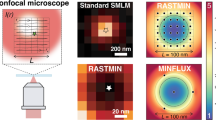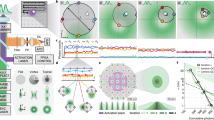Abstract
We developed a method to use any GFP-tagged construct in single-molecule super-resolution microscopy. By targeting GFP with small, high-affinity antibodies coupled to organic dyes, we achieved nanometer spatial resolution and minimal linkage error when analyzing microtubules, living neurons and yeast cells. We show that in combination with libraries encoding GFP-tagged proteins, virtually any known protein can immediately be used in super-resolution microscopy and that simplified labeling schemes allow high-throughput super-resolution imaging.
This is a preview of subscription content, access via your institution
Access options
Subscribe to this journal
Receive 12 print issues and online access
$259.00 per year
only $21.58 per issue
Buy this article
- Purchase on Springer Link
- Instant access to full article PDF
Prices may be subject to local taxes which are calculated during checkout


Similar content being viewed by others
References
Betzig, E. et al. Science 313, 1642–1645 (2006).
Rust, M.J., Bates, M. & Zhuang, X. Nat. Methods 3, 793–795 (2006).
Heilemann, M. et al. Angew. Chem. Int. Edn. Engl. 47, 6172–6176 (2008).
Fölling, J. et al. Nat. Methods 5, 943–945 (2008).
Rothbauer, U. et al. Nat. Methods 3, 887–889 (2006).
Bates, M., Blosser, T.R. & Zhuang, X. Phys. Rev. Lett. 94, 108101 (2005).
Heilemann, M., Margeat, E., Kasper, R., Sauer, M. & Tinnefeld, P. J. Am. Chem. Soc. 127, 3801–3806 (2005).
Juette, M.F. et al. Nat. Methods 5, 527–529 (2008).
Manley, S. et al. Nat. Methods 5, 155–157 (2008).
Huh, W.-K. et al. Nature 425, 686–691 (2003).
Hartwell, L.H. Exp. Cell Res. 69, 265–276 (1971).
Baddeley, D. et al. PLoS ONE 6, e20645 (2011).
Byers, B. & Goetsch, L. J. Cell Biol. 69, 717–721 (1976).
Cid, V.J., Adamiková, L., Sánchez, M., Molina, M. & Nombela, C. Microbiology 147, 1437–1450 (2001).
Chen, H., Howell, A.S., Robeson, A. & Lew, D.J. Biol. Chem. 392, 689–697 (2011).
Kaech, S. & Banker, G. Nat. Protoc. 1, 2406–2415 (2006).
Amberg, D.C., Burke, D. & Strathern, J.N. Methods in Yeast Genetics. (Cold Spring Harbor Laboratory Press, 2005).
Edelstein, A., Amodaj, N., Hoover, K., Vale, R. & Stuurman, N. Curr. Protoc. Mol. Biol. 14.20 (2010).
Schoen, I., Ries, J., Klotzsch, E., Ewers, H. & Vogel, V. Nano Lett. 11, 4008–4011 (2011).
Smith, C.S., Joseph, N., Rieger, B. & Lidke, K.A. Nat. Methods 7, 373–375 (2010).
Juette, M.F. & Bewersdorf, J. Nano Lett. 10, 4657–4663 (2010).
Acknowledgements
This work was supported by a Marie Curie Intra-European Fellowship (J.R.) the National Center for Competence in Biomedical Imaging and the National Center for Competence in Research 'Neural Plasticity and Repair'. We thank Y. Barral and members of the Barral laboratory for useful discussions, help with yeast strains and access to the yeast genomic GFP-fusion library, R. Dechant for help with elutriation and M. Stoeber for help with Amaxa transfection.
Author information
Authors and Affiliations
Contributions
H. Ewers conceived of the project; J.R., C.K., E.P. and H. Ewers designed experiments; J.R., C.K., E.P., H. Eghlidi & H. Ewers performed and analyzed experiments; H. Ewers and J.R. wrote the paper.
Corresponding author
Ethics declarations
Competing interests
The authors declare no competing financial interests.
Supplementary information
Supplementary Text and Figures
Supplementary Figures 1–5 and Supplementary Note (PDF 3815 kb)
Rights and permissions
About this article
Cite this article
Ries, J., Kaplan, C., Platonova, E. et al. A simple, versatile method for GFP-based super-resolution microscopy via nanobodies. Nat Methods 9, 582–584 (2012). https://doi.org/10.1038/nmeth.1991
Received:
Accepted:
Published:
Issue Date:
DOI: https://doi.org/10.1038/nmeth.1991
This article is cited by
-
Image restoration of degraded time-lapse microscopy data mediated by near-infrared imaging
Nature Methods (2024)
-
Spectroscopic single-molecule localization microscopy: applications and prospective
Nano Convergence (2023)
-
Extreme thermal stability of the antiGFP nanobody – GFP complex
BMC Research Notes (2023)
-
RegiSTORM: channel registration for multi-color stochastic optical reconstruction microscopy
BMC Bioinformatics (2023)
-
Heat denaturation enables multicolor X10-STED microscopy
Scientific Reports (2023)



